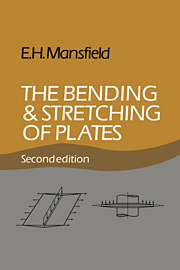Book contents
- Frontmatter
- Contents
- Preface
- Principal notation
- Part 1 Small-deflexion theory
- 1 Derivation of the basic equations
- 2 Rectangular plates
- 3 Plates of various shapes
- 4 Plates whose boundaries are amenable to conformal transformation
- 5 Plates with variable rigidity
- 6 Approximate methods
- Part II Large-deflexion theory
- Author index
- Subject index
1 - Derivation of the basic equations
Published online by Cambridge University Press: 07 October 2009
- Frontmatter
- Contents
- Preface
- Principal notation
- Part 1 Small-deflexion theory
- 1 Derivation of the basic equations
- 2 Rectangular plates
- 3 Plates of various shapes
- 4 Plates whose boundaries are amenable to conformal transformation
- 5 Plates with variable rigidity
- 6 Approximate methods
- Part II Large-deflexion theory
- Author index
- Subject index
Summary
All structures are three-dimensional, and the exact analysis of stresses in them presents formidable difficulties. However, such precision is seldom needed, nor indeed justified, for the magnitude and distribution of the applied loading and the strength and stiffness of the structural material are not known accurately. For this reason it is adequate to analyse certain structures as if they are one- or two-dimensional. Thus the engineer's theory of beams is one-dimensional: the distribution of direct and shearing stresses across any section is assumed to depend only on the moment and shear at that section. By the same token, a plate, which is characterized by the fact that its thickness is small compared with its other linear dimensions, may be analysed in a two-dimensional manner. The simplest and most widely used plate theory is the classical small-deflexion theory which we will now consider.
The classical small-deflexion theory of plates, developed by Lagrange (1811), is based on the following assumptions:
(i) points which lie on a normal to the mid-plane of the undeflected plate lie on a normal to the mid-plane of the deflected plate;
(ii) the stresses normal to the mid-plane of the plate, arising from the applied loading, are negligible in comparison with the stresses in the plane of the plate;
(iii) the slope of the deflected plate in any direction is small so that its square may be neglected in comparison with unity;
[…]
- Type
- Chapter
- Information
- The Bending and Stretching of Plates , pp. 3 - 32Publisher: Cambridge University PressPrint publication year: 1989



